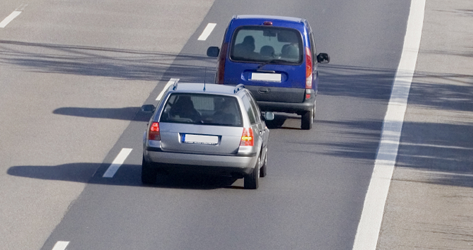Tailgaters: whether we’ve done it ourselves or had it done to us, there’s not a single driver on the road who hasn’t had the misfortune of dealing with them. We’re encouraged as drivers by law to not engage, but little is explained as to why it’s so important to yourself, your passengers and the people in front of you.
Not only is tailgating very annoying as the person being followed closely, it’s incredibly dangerous to everyone involved. We tend to think that being in a secure hunk of metal keeps us safe – and while that’s true, people who tailgate are missing a crucial piece in their logic: stopping distance and how it’s negatively affected by speed.
The faster a car is going, the more space a car needs to stop and speed isn’t the only contributor, either. If it’s rainy, hot, snowy or cold, it will affect the amount of time, space and just how effective your car will be able to come to a full stop. More factors to figure in are road conditions – whether or not the road is smooth, bumpy or if you’re going uphill or downhill.
Even with the anti-lock brake systems (ABS) now standard by law on all cars made after 2013 (thankfully, most manufactures were making them standard long before then), the likeliness of stopping completely, efficiently and effectively still decrease when conditions aren’t perfect. Given the general road conditions in California, they’re rarely optimal.
Here’s a very difficult equation simplified by the National Association of City Transportation Officials (NACTO): the three most important factors in stopping distance are driver reaction time (which can change, depending on age and energy levels), road conditions and speed. If a car is going 60 miles per hour (mph) and with the average reaction time being around 1.5 seconds, it would take the car approximately 6.87 seconds (at ~88 feet per second) after traveling 304.28 feet to come to a complete stop. Which, when put into perspective, is slightly longer than the length of a football field.
NACTO provided a chart on its website displaying these figures: at 70 mph, the stopping distance goes up to 388 feet for a complete stop. At 80mph, it leaps to 481 feet. At 85 mph, it’s 532 feet. So, realistically, an extra 5 mph over the speed limit is 84 feet of stopping distance, which is why it’s a good to have a distance of about five car-lengths between you and the person in front of you.It’s worth noting that trucks, vans and SUVS typically weigh 2.5 tons (5,000 pounds) or more. Therefore, the stopping distance is longer and slower for these vehicles. With a car that heavy following closely, they’ll do a lot more damage to the vehicle in front of them than a sedan would, even at 65 mph.
Think of it this way: If a car is following behind you at 5-10 feet at the typical 65-75 mph, they wouldn’t be able to stop in time in such a short distance – instead, they’d plow right into the back of your car. With as much momentum that a heavy car would have at that speed, the likeliness of the damages being fatal increase with how close and quickly they’re following behind.

